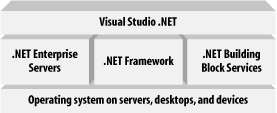1.2 The .NET Platform
The Microsoft .NET platform consists of five main components, as shown in Figure 1-1. At the lowest layer lies the operating system (OS), which can be one of a variety of Windows platforms, including Windows XP, Windows 2000, Windows Server 2003, Windows ME, and Windows CE. As part of the .NET strategy, Microsoft has promised to deliver more .NET device software to facilitate a new generation of smart devices.
Figure 1-1. The Microsoft .NET platform

On top of the operating system is a collection of specialized server products that shortens the time required to develop large-scale business systems. These server products include Application Center, BizTalk Server, Commerce Server, Exchange Server, Host Integration Server, Internet Security and Acceleration Server, and SQL Server.
Since web services are highly reusable across the Web, Microsoft provides a number of building-block services (officially called .NET Services) that applications developers can use, for a fee. Two examples of .NET Services that Microsoft offers include .NET Passport and .NET Alerts. .NET Passport allows you to use a single username and password at all web sites that support Passport authentication. .NET Alerts allow .NET Alert providers, such as a business, to alert their consumers with important or up-to-the-minute information. Microsoft plans to add newer services, such as calendar, directory, and search services. Third-party vendors are also creating new web services of their own.
The top layer of the .NET architecture is a development tool called Visual Studio .NET (VS.NET), which makes possible the rapid development of web services and other applications. A successor to Microsoft Visual Studio 6.0, VS.NET is an Integrated Development Environment (IDE) that supports four different languages and features such as cross-language debugging and the XML Schema Editor.
And at the center of .NET is the Microsoft .NET Frameworkthe main focus of this book. The .NET Framework is a development and runtime infrastructure that changes the development of business applications on the Windows platform. The .NET Framework includes the CLR and a common framework of classes that can be used by all .NET languages.







